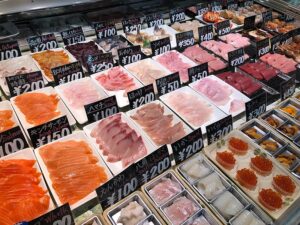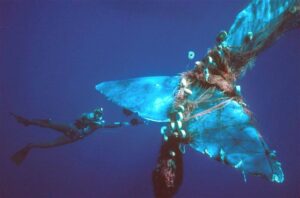
While I was sitting at home one night, I decided to watch a new Netflix documentary titled “Seaspiracy.” The name was catchy and seemed interesting as I love learning about the ocean and our waterways. Little did I know that I was in for a rude awakening.
While watching this movie I was exposed to information that I could not believe was real. Don’t get me wrong—I understand that greenwashing is a common thing. I just didn’t think it was so common in the “sustainable” seafood industry. Seaspiracy argues that fisheries are still operating at full capacity and diminishing our oceans at alarming rates.
What is sustainable seafood?
According to the Marine Stewardship Council (MSC) sustainable seafood means the fish was caught:
- From stocks with healthy populations
- With minimal impact on the marine environment
- In an area with effective, responsive, and responsible management.
This sounds amazing. But it is far from the truth.
Sustainability should involve all three of the previous concepts and protect our fishing industry for the long run. Unfortunately, most of the policing that should be going on does not actually occur, and the MSC cannot be certain that the seafood they are certifying as “sustainable” is actually sustainable.
As a result, consumers purchasing these products, which are usually more expensive, think they are being environmentally friendly when in reality it is most likely business as usual for the seafood fisheries.
This is not to say though that sustainable fishing is not a thing. It most certainly is. However, I do not think it is happening at a rate that actually protects fish populations for generations to come.
So, what’s going wrong?
While watching Seaspiracy, I took notes on a few issues that make the sustainable fishing industry unsustainable.
- Overfishing
- Bycatch, a large issue that has not been resolved
- Trawling and pollution from fishing
- Sustainable certification = more profits
Overfishing
Once I learned that sustainable fishing industries are still overfishing I decided to look more into this issue. When I did, I came across an older, but still important report, about the state of the world fisheries and aquaculture written by the United Nations. It states that the world’s fisheries are often overexploited. No surprise there. However, the surprise comes when the report mentions that approximately 30% of the sustainable fisheries industries are also overexploited.
Furthermore, approximately 60% of this industry is still catching fish very close to that overexploitation limit, thus harming the industry. Overall, overfishing has not slowed and is still a common theme for a so called sustainable industry.
Bycatch
Perhaps one of the most heart melting things occurring in the sustainable seafood industry is large bycatch. Bycatch is basically all of the fish caught in nets that fisherman do not have a use for, fish they cannot keep, or fish they cannot sell.
Some of this bycatch is dolphins, sharks, whales, sea turtles, seabirds—the list goes on and on. And no, it’s not just charismatic species being caught as bycatch. This is not just a rare occurrence. This happens all the time. All across the world. In every fishery.
When apex species like sharks die from being unintentionally caught, the whole ocean ecosystem can be thrown out of balance. If the ocean loses sharks, then we as humans will lose the fish in the ocean, an ecosystem essential to our survival as a species.
Trawling and Pollution from Fishing
Let’s just take a moment and say hypothetically that these industries are doing the best they can to keep the seafood industry sustainable. That’s great! But this will never be a reality unless fishing techniques change.
Currently, lots of fishing industries use a method known as trawling, where large heavy nets are dragged across the seafloor to catch as much seafood as they can in one big swoop. Trawling destroys coral reefs, fish populations, and increases the amount of bycatch.

Another important issue is pollution from the fishing industries. When people hear about ocean plastic pollution, they mostly think of straws, plastic baggies, water bottles, and styrofoam. While these are all relevant pollutants, one of the largest ocean pollutants is gear from the fishing industry. Estimates project that approximately 44% of ocean plastic pollution is caused by the fishing industry. Let that sink in.
New technologies need to be pursued to solve both of these problems. If we want to create a more sustainable industry we need to also create one that’s clean.
Profits
When I first watched Seaspiracy, I felt strongly about calling out certification companies like the MSC. Media outlets as reputable as NPR also question how companies ensure the seafood is sustainable. Well, most of the time they cannot.
Many certification companies rely on either third parties to conduct enforcement or on captains’ words. If you were a captain and heard you could make more money by labeling your product as sustainable with no enforcement would you still do it?
In essence, sustainability equals profit for everyone involved no matter the fishing process.
Concluding Thoughts
As I think about all the times I thought I was being environmentally conscious by purchasing sustainable seafood, I now feel like a fool. This is not to say there aren’t sustainable industries out there because there are. But we need to be more aware of what we’re buying.
So what can we do? Two things:
- Drastically reduce your seafood consumption, or do not eat seafood at all. This is a harsh take but it’s the most reliable way to ensure our oceans stay healthy.
- Only eat seafood if you know exactly where it came from and how it was caught.
We can also create a call to action for governments to do a better job of enforcing the sustainable seafood industry. Finally, eating seafood such as oysters, clams or seaweed is proven to be sustainable and can even work to clean our oceans.
By changing how we view sustainable seafood we can ensure a safer tomorrow for our oceans.
